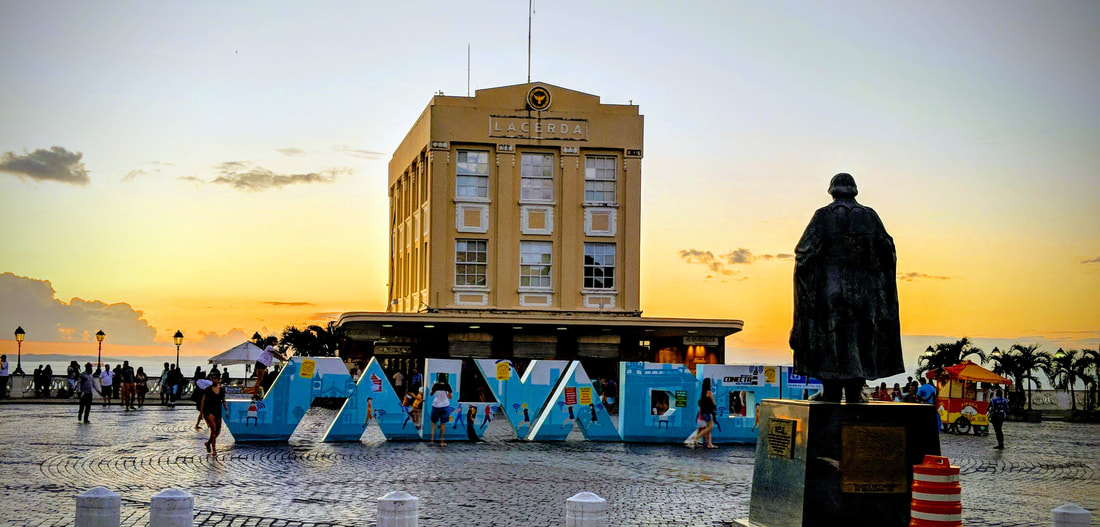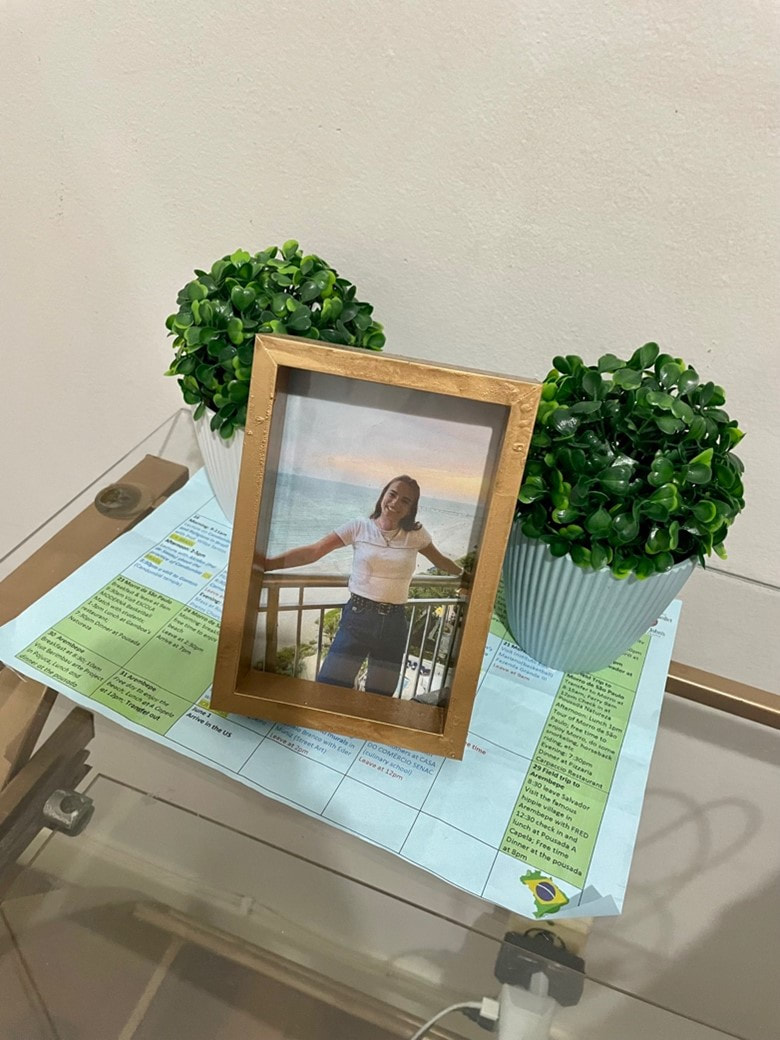|
By Hailee Thayer In the two weeks that we’ve been in Bahia, Brazil, we have learned more about the culture and political landscape than we could ever have in the classroom. We have been staying with a host family, which allowed us to immerse ourselves fully in Brazilian culture. I first started noticing Brazilian Elections and politics. On the first day, we were driving from the airport to the hotel. There was a lot of graffiti, but one that stuck out to me was the phrase “Fora Bolsonaro” which translates to “Out Bolsonaro” in English. This has still stayed with me and shows the general political leaning of the city. This dynamic is even present in my host home. When I returned home one night, I went to sit with my host dad to watch soccer. At first he turned on the news and turned-on CNN. The Republican Primaries were on, and the topic of conversation turned to politics. My host dad asked if Trump still had a following in the United States, I responded yes and used it as an opportunity to see which way he leaned. I asked if he liked Bolsonaro, and he replied “No, I think he is a bad ruler and a bit authoritarian”. This is a common thought with everyone that I’ve interacted with. I also learned that Lula, served as the Brazilian President from 2003 to 2010, was instrumental for rural communities, specifically for education. Lula and Dilma Rousseff introduced quotas to the Brazilian education system for higher education. These quotas are there in order to diversify the population of higher education institutions. They have greatly increased the number of Black students that attend both public and private universities. On that same train of thought, gender quotas have increased the presence of women in Brazilian Political Parties. But despite the quota, the number of women elected to government positions remains low (Gatto and Wylie 2021, 3). The representation of women in politics is an important issue to me, and to see gender quotas working (even if the number of women in government positions is still what we consider to be low), it gives me hope for the future. Another important aspect of Brazilian culture is Carnaval. Many people think of Carnaval as a big parade with extravagant costumes, but it is so much more than that. Carnaval used to be a celebration for Brazilian Elites (also known as the Portuguese/Europeans) and would take place inside houses. Salves during this time started dancing and celebrating in the streets. This later became what Carnaval is today. It represents racial pride and many of the songs and instruments played are of African origin. Carnaval in Rio de Janeiro “became the most holy ritual of mestiço nationalism and the celebration of mestiçagem” (Eakin 2017, 91). Mestiçagem refers to ‘the mixing’ and is the term for the mixing of mainly African and Indigenous people, but also between African, Indigenous, and European people. This idea was present during Carnaval, but now Carnaval is a celebration of Black Pride. We also went to Casa do Carnaval, a museum all about the history and culture of Carnaval. We saw costumes from different ‘blocos’ or Carnaval groups. We also saw different individual costumes and one of them reminded me about the Mulata we read about in class. The Mulata is described as “thee most potent image of Brazilian sexuality” (Eakin 2017, 108). The Mulata became the ideal type of woman that every woman aspired to be. These lead to interesting gender dynamics within Brazilian society, but also within Carnaval itself. Below is an image of a costume that a woman wore during Carnaval. The dress itself looks like it emphasizes the chest area of the woman and her curves with how tight the dress is. There are still manifestations of the Mulata in Brazilian society and Carnaval. The last interesting and important aspect of Brazilian culture are Afro-Brazilian religions. The one we learned the most about is Candomblé. This is a religion that was created through syncretism. Syncretism is the “process by which elements of 1 religion are assimilated into another religion resulting in a change in the nature of the religion. It creates an entirely new religion” (Lecture on Umbanda and Candomblé, May 16, 2022). When the Slave Trade was going on in Brazil, African people were taken from all over the continent and brought them to Brazil. This created a mixing of different religious traditions and customs and with Catholicism which resulted in Umbanda and Candomblé. In Candomblé, practioners worship 12 spirits, or gods, called Orixás. The Orixás that are recognized in Brazil are Oxalá, Lemanjá, Xangô, Iansã, Oxóssi, Ogum, Oxum, Exú, Omulu, Nanã, Ossaim, and Oxumaré. Because of the mixing with Catholicism, the Orixás have been associated with Catholic Saints. For example, the Orixá, Oxalá is associated with Jesus. Each Orixá is associated with a color and nature element as well as having a unique symbol. Many Brazilians practice Candomblé and I consider it to be a key aspect of Afro-Brazilian culture and heritage. Works Cited Eakin, Marshall C. “Communicating and Understanding Mestiçagem Radio, Samba, and Carnaval.” Essay. In Becoming Brazilian: Race and National Identity in Twentieth-Century Brazil, 79–106. Cambridge University Press, 2017. Eakin, Marshall C. “Visualizing Mestiçagem Literature, Film, and the Mulata.” Essay. In Becoming Brazilian: Race and National Identity in Twentieth-Century Brazil, 107–35. Cambridge University Press, 2017. Gatto, Malu AC, and Kristin N Wylie. “Informal Institutions and Gendered Candidate Selection in Brazilian Parties.” Party Politics, 2021, 1–12. https://doi.org/10.1177/13540688211008842. Santos, Willys. Lecture on “Umbanda and Candomblé: The History, Tenets, and Practices” May 16, 2022, Salvador, Brazil.  Hailee Thayer recently graduated from the College of Saint Benedict and Saint John's University with a major in Political Science and a minor in Gender Studies. She is from Prior Lake Minnesota. Hailee enjoys learning about the intersection of gender and aspects of everyday life as well as political representation. Hailee also enjoys reading in her free time and playing rugby.
0 Comments
By Lizbet Martinez and Fabian Venegas Ramos On the day we are writing this, we have been in Bahia for 12 days. Through our educational program, we have learned about various topics related to race, gender, and inequality in Brazil including the education system, religion, and expansive history lessons. Some of our favorite lectures and experiences, however, have been centered on music and dance. These two mediums are more than just entertainment, but cultural ways of being, building community, and (re)connecting to ancestral roots. It has been an energizing and empowering experience to engage and interact with various cultural forms of dance and music unique to Brazil. On the evening of our first full day in Bahia, we had a capoeira workshop with Mestre Sapoti. Capoeira is a Brazilian martial art that combines elements of dance, movement, and music. Mestre Sapoti discussed the origins of capoeira and how it came from the enslaved Africans in Brazil and was used as a form of self-defense disguised as dance. We learned how to do the ginga, the basic step, as well as a few offensive and defensive moves. We also learned about the musical instruments used to play the music for capoeira and the call and response songs that people sing. It was emphasized that people do not fight capoeira, but it is something that is played. It remains a very important part of Afro-Brazilian tradition and can be seen in the streets just about anywhere in Bahia. The workshop was a great way for us to dive into Brazilian culture. We also had the incredible opportunity of learning Afro-Brazilian dance with Antonio Cozido, creator of Swing Afro Baiano. His zealous attitude, cheerful chants, and words of wisdom created an unforgettable experience for us both, one that we have been looking forward to since the start of the course on campus. To begin the dancing workshop, we did some grounding exercises to connect to our body’s five senses and to connect with our surrounding environment. He also re-introduced us to a Yoruba word used in Candomblé religion – Axé, which means “energy.” “AXÉ! AXÉ! AXÉ!” echoed throughout the room as we all chanted together several times throughout the workshop to reinvigorate each other’s energy. We learned how to dance Samba, Folha, and other dances that are popular in Brazil. The dances were all distinct from one another; some were easier to remember, some sensual and slow, and others upbeat and fast-paced. Samba, more specifically, is a Brazilian dance that is considered one of the most representative elements of Brazilian culture. Compared to other dance styles, Samba was a unique and fun dance to learn. The emergence and spread of Samba in the 1920s was a popular sensation and in the 30s fused with carnaval, becoming emblematic of Brazil’s cultural identity. Samba was distinctly used to enhance a national identity and connect the regions of Brazil, which at the time were developing their own unique and competing music sounds. The most influential radio station of Brazil in the 1940s—Rádio Nacional, for example, “promoted the song heavily, and openly declared samba and its sentiments as the core of national identity” (Eakin 2017, p. 204). Together, popular media and the state pushed Samba as a cultural piece that would build bridges between cultural groups and create the Brazilian people. Like samba, another essential aspect of Brazilian culture is the carnaval. We were able to visit the Casa do Carnaval museum in Bahia to learn about the importance of carnaval in Brazil. As Eakin explains, carnaval “emerged in the 1930s and 1940s as the principal ritual showcasing the Freyrean vision…it became the most holy ritual of mestiço nationalism and the celebration of mestiçagem” (2017, 204). It is a ritual and national festivity that comes from European roots but is grounded in various Brazilian (particularly afro-Brazilian) traditions. At the museum we got to see colorful costumes, did an interactive dance experience, and saw how carnaval brings all people together. Similarly, music had an instrumental role in creating the national identity of Brazil that is known today. The rise in popular music contributed to ethnic mixing for indigenous, African, and Portuguese people, allowing various styles to form, interact, and fuse with each other. Eakin (2017) states, “The cultural arena provided Brazilians opportunities for participation and belonging that were not open to them in the political arena, especially during the years of dictatorship” (p. 202). This highlights how popular music was fundamental for Brazilian culture and citizenship because it created space for Brazilians of different groups, particularly those existing in the margins, to engage with its production and consumption. This was demonstrated in the Percussion Workshop we had with Mario Pam. We saw and learned to play instruments with either indigenous roots, African roots, or European roots. These different instruments became used by other cultural groups to create and influence new music forms. This allowed different cultures to be represented and be part of an “imagined community.” Our unique experience has demonstrated to us that inequality and racial injustice is prevalent in every aspect of life in Brazil. We see it very clearly in the arts that are often rooted in afro-Brazilian culture and are used as a means to fight back against discrimination and injustice. From capoeira to samba to carnaval, people are taking up space and keeping traditions alive. The arts experiences that we have been fortunate enough to have gone through have not only taught us about the issues, but we were fully immersed in experiencing the response to those issues. We know we will take with us the understanding and skills we learned, and we hope to be able to spread the wisdom, strength, and passion we acquired through the workshops and lectures. Eakin, Marshall C. 2017. “The Sounds of Cultural Citizenship.” Chapter. In Becoming Brazilians: Race and National Identity in Twentieth Century Brazil. 200–219. New Approaches to the Americas. Cambridge: Cambridge University Press.  Lizbet Martinez-Port is a senior at the College of Saint Benedict studying political science and Hispanic studies. She is from Minneapolis, Minnesota and enjoys learning about topics that intersect within her majors. She is passionate about immigration reform, as well as other social justice issues. On campus, she sings, dances, and acts. She looks forward to learning about a new culture and language during her time abroad in Brazil.  Fabian Venegas-Ramos is from Immokalee, Florida. They are a senior, soon to be graduate of the College of Saint Benedict and Saint John's University. They will be receiving their bachelor's degree in Sociology and Gender Studies. Fabian is passionate about social justice, and queer and trans rights and activism. They look forward to immersing themselves in the Brazilian culture through music, dance, and food! |
Archives
December 2023
Categories
All
|




 RSS Feed
RSS Feed
